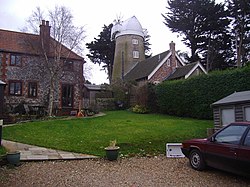스탠딩 사이클
Standing cycling서서 자전거를 타거나 안장 밖으로 자전거를 타는 것은 운전자가 페달에 힘을 가하면서 일어나는 사이클링의 한 형태입니다.
근육 활성화
서서 자전거를 타는 이유 중 하나는 사용하는 근육을 다양하게 하고 [1]피로를 피하기 위해서입니다.
효율과 출력
서서 자전거를 타는 것은 특히 [2]강도가 낮을 때 효율이 떨어진다.한 연구에 따르면 두 위치 모두 최대 86VoO max에서 소모되는 시간이 같으며, 일어서서 소모되는 시간은 최대 [3]94% VoO max 이상이었다.2018년 엘리트 남성 사이클 선수들을 대상으로 한 연구는 선 자세가 에너지 비용에 영향을 미치지 않고 롤링 저항력, 롤링 저항 계수, 횡방향 흔들림을 포함한 기계 비용이 증가하여 같은 [4][5]속도를 유지하는 데 필요한 전체 동력 4.3 퍼센트가 증가했다는 것을 발견했습니다.2017년의 한 연구는 사람들이 자전거를 탈 때 근육의 [6]힘을 최소화하기 위해 자발적으로 일어선다는 것을 발견했다.
일어서서 사이클을 하면 전진 [7][8]동작에 체중을 가하기 때문에 단기적으로 더 큰 출력을 낼 수 있습니다.
몸이 가벼운 사람은 일어서면 효율이 떨어지기 때문에 알베르토 콘타도르와 같은 가벼운 프로 라이더들이 [9][5]일어서는 모습을 자주 볼 수 있다.
사용된 자전거의 종류
스탠딩 사이클은 착석 [10]시보다 크랭크 길이가 짧을수록 효율적입니다.자전거 중에는 서서 [11]탈 수 있는 것이 있습니다.
레퍼런스
- ^ Neef, Matt de (12 June 2018). "What you should know about riding out of the saddle". CyclingTips. Retrieved 20 July 2022.
- ^ Arkesteijn, Marco; Jobson, Simon; Hopker, James; Passfield, Louis (2016). "The Effect of Cycling Intensity on Cycling Economy During Seated and Standing Cycling" (PDF). International Journal of Sports Physiology and Performance. 11 (7): 907–912. doi:10.1123/ijspp.2015-0441. PMID 26788845. S2CID 31549343.
- ^ Hansen, Ernst A.; Waldeland, Harry (2008). "Seated versus standing position for maximization of performance during intense uphill cycling". Journal of Sports Sciences. 26 (9): 977–984. doi:10.1080/02640410801910277. PMID 18569564. S2CID 43911796.
- ^ Bouillod, Anthony; Pinot, Julien; Valade, Aurélien; Cassirame, Johan; Soto-Romero, Georges; Grappe, Frédéric (2018). "Influence of standing position on mechanical and energy costs in uphill cycling". Journal of Biomechanics. 72: 99–105. doi:10.1016/j.jbiomech.2018.02.034. PMID 29559241.
- ^ a b Neef, Matt de (12 June 2018). "What you should know about riding out of the saddle". CyclingTips. Retrieved 20 July 2022.
- ^ Costes, Antony; Turpin, Nicolas A; Villeger, David; Moretto, Pierre; Watier, Bruno (2018). "Spontaneous change from seated to standing cycling position with increasing power is associated with a minimization of cost functions". Journal of Sports Sciences. 36 (8): 907–913. doi:10.1080/02640414.2017.1346272. ISSN 0264-0414. PMID 28671851. S2CID 4580966.
- ^ So, Raymond C.H.; Ng, Joseph K.-F.; Ng, Gabriel Y.F. (2005). "Muscle recruitment pattern in cycling: a review". Physical Therapy in Sport. 6 (2): 89–96. doi:10.1016/j.ptsp.2005.02.004.
- ^ Turpin, Nicolas A.; Costes, Antony; Moretto, Pierre; Watier, Bruno (2017). "Can muscle coordination explain the advantage of using the standing position during intense cycling?". Journal of Science and Medicine in Sport. 20 (6): 611–616. doi:10.1016/j.jsams.2016.10.019.
- ^ "Should you sit or stand when climbing?". Cyclist. Retrieved 20 July 2022.
- ^ Park, Sumin; Roh, Jongryun; Hyeong, Joonho; Kim, Sayup (2022). "Effect of crank length on biomechanical parameters and muscle activity during standing cycling". Journal of Sports Sciences. 40 (2): 185–194. doi:10.1080/02640414.2021.1982516. PMID 34581253. S2CID 238203805.
- ^ Kaminski, Joseph. "Halfbike 3 stand-up bike hands-on: A full workout". CNET. Retrieved 20 July 2022.
추가 정보
- Jones, Andrew M.; Berger, Nicolas J. A.; Wilkerson, Daryl P.; Roberts, Claire L. (2006). "Effects of "priming" exercise on pulmonary O 2 uptake and muscle deoxygenation kinetics during heavy-intensity cycle exercise in the supine and upright positions". Journal of Applied Physiology. 101 (5): 1432–1441. doi:10.1152/japplphysiol.00436.2006. PMID 16857860.
- Turpin, Nicolas A.; Costes, Antony; Moretto, Pierre; Watier, Bruno (2016). "Upper limb and trunk muscle activity patterns during seated and standing cycling". Journal of Sports Sciences: 1–8. doi:10.1080/02640414.2016.1179777. PMID 27136397. S2CID 25394025.




